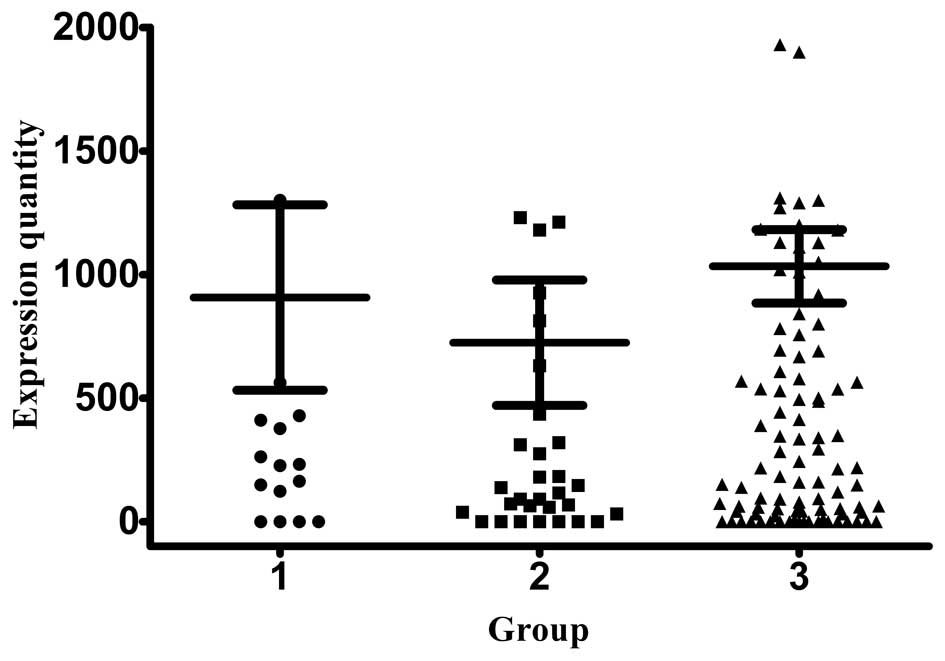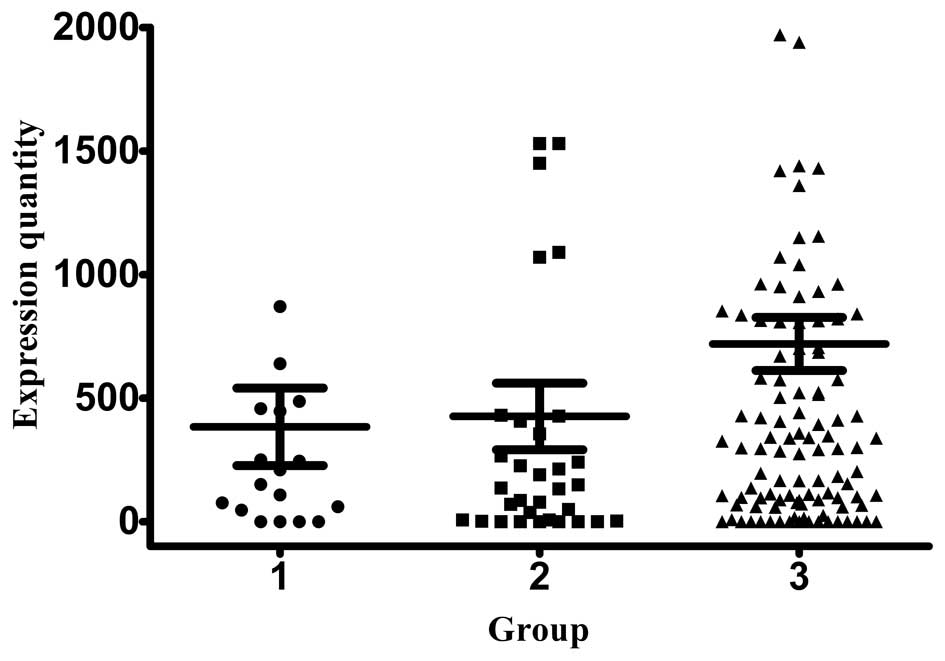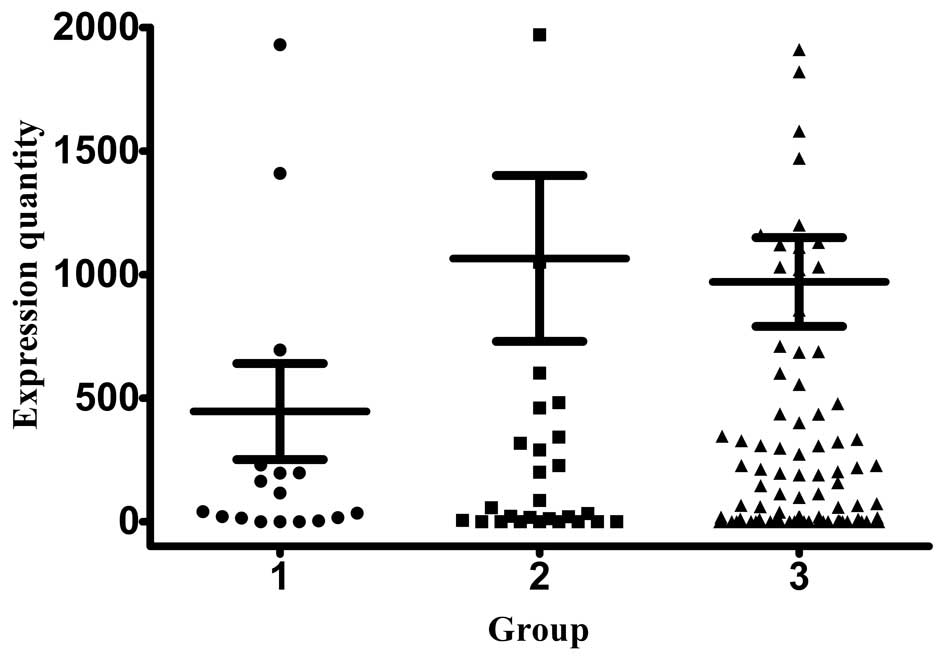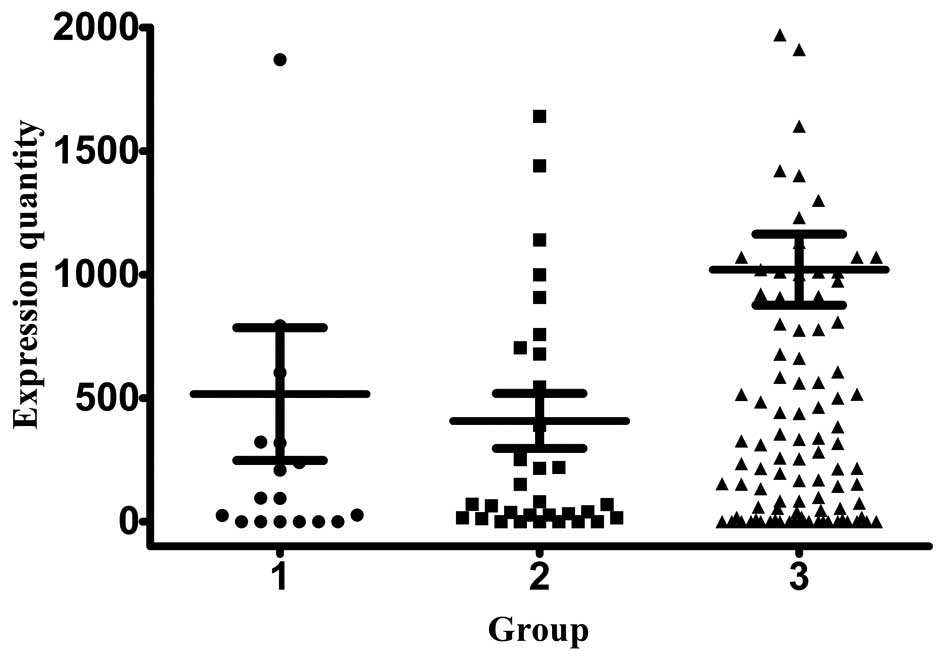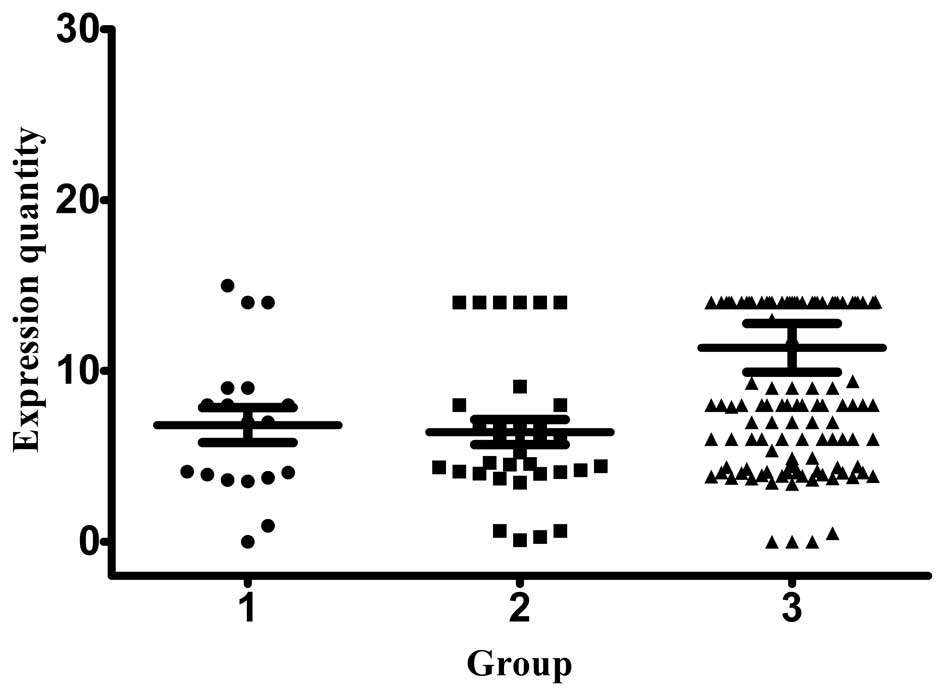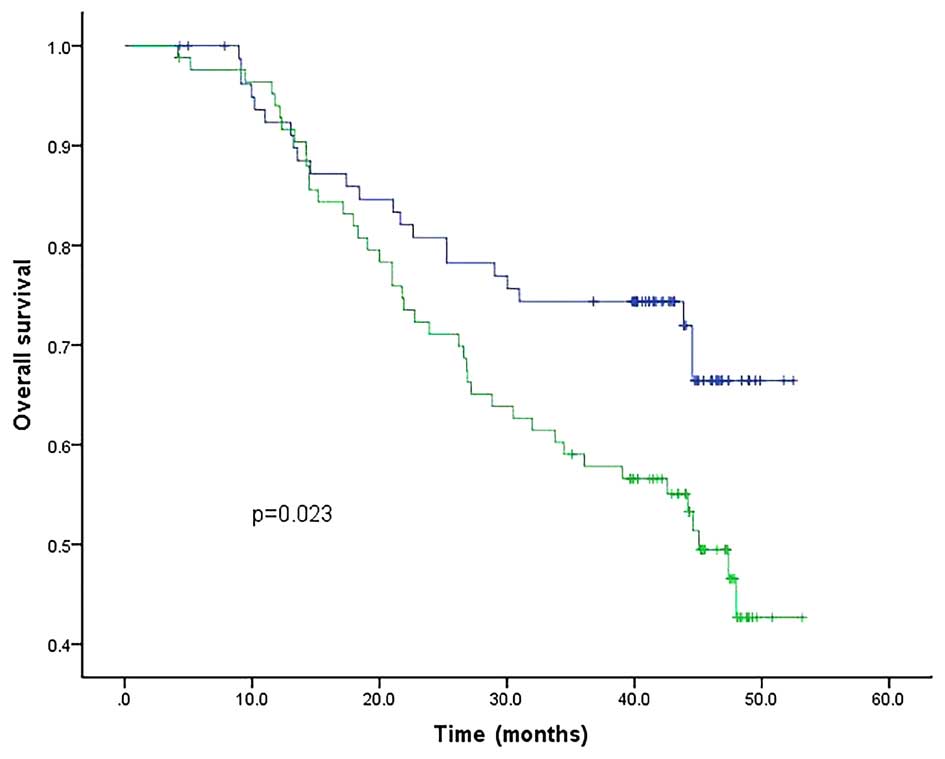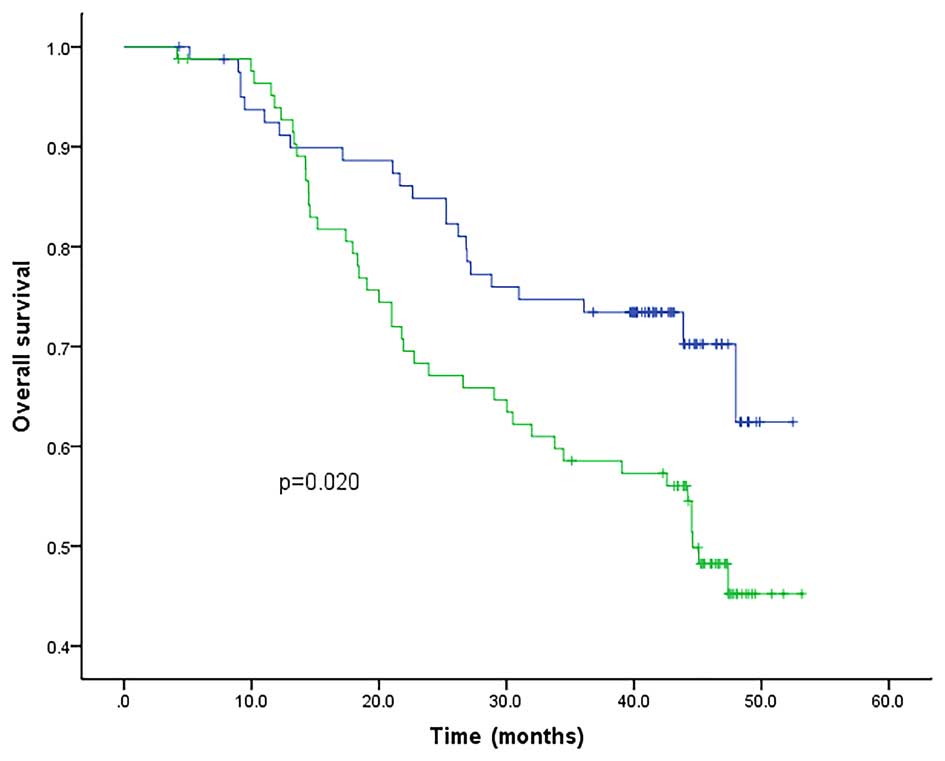Upregulation of circulating cytokeratin 20, urokinase plasminogen activator and C-reactive protein is associated with poor prognosis in gastric cancer
- Authors:
- Published online on: August 18, 2015 https://doi.org/10.3892/mco.2015.624
- Pages: 1213-1220
-
Copyright: © Tang et al. This is an open access article distributed under the terms of Creative Commons Attribution License.
Abstract
Introduction
As one of the most common types of cancer worldwide, gastric cancer remains the second leading cause of cancer-related mortality (1). Although the survival rate has improved gradually over the past 30 years, the overall 5-year survival rate of resectable gastric cancer remains high (10–30%), which is mainly due to the fact that the majority of gastric cancers are diagnosed at an advanced rather than an early stage (2,3). A significant proportion of patients with advanced cancer succumb to complications caused by metastases, rather than the primary tumor. Numerous factors are associated with gastric cancer prognosis, including growth factors and their receptors, cell cycle regulators, cell adhesion molecules and matrix-degrading enzymes, all of which play important roles in cell proliferation, invasion and metastasis (4). Several putative tumor markers, including p53, carbohydrate antigen (CA) 19-9, CA72-4, human epidermal growth factor receptor 2 and pituitary tumor-transforming gene 1, have been described as potential prognostic indicators for gastric cancer behavior (3,5–8). However, there is increasing interest in identifying novel prognostic factors to improve the current treatment regimens and develop novel therapeutic targets.
Cytokeratin (CK) is an intermediate filament observed mainly in epithelial cells, which is involved in cell morphology through providing mechanical and structural support. The tissue distribution of the 20 subtypes of CK depends on the type of epithelium and the stage of differentiation. Therefore, this CK fingerprint may enable distinguishing primary tumors and their metastases from other type of carcinomas, as the former two share the same pattern (9–11). It has been demonstrated that CYFRA 21-1, the fragment of CK19, is a serum biomarker providing useful prognostic information in lung, breast, pancreatic and colorectal cancer (12–15). However, the role of CK19 in gastric cancer remains unknown. As another important diagnostic marker, CK20 is specifically found in gastrointestinal epithelium; therefore, it normally functions as a diagnostic marker in combination with CK7 to differentiate primary and metastatic cancers in non-GI tissues, such as lung, prostate and ovary (11). Urokinase plasminogen activator (uPA) catalyzes the conversion of the proenzyme plasminogen to the active protease plasmin, which regulates a number of physiological processes requiring basement membrane and/or extracellular matrix (ECM) remodeling, such as tissue regeneration and angiogenesis, as well as cancer progression and metastasis (16). uPA has been found to be a poor prognostic marker for breast and other types of cancer (17,18). Similar to uPA, members of the matrix metalloproteinase (MMP) family are also important for tumor cell invasion and metastasis. As a type IV collagenase, MMP-9 is able to degrade type IV collagen, which is the major component of basement membranes, thereby facilitating tumor spreading (19). Increased MMP-9 expression is associated with disease progression and poor prognosis in breast, ovarian and hepatic cancer (20–23). Recently, a meta-analysis of 11 retrospective studies was conducted to investigate the prognostic effect of MMP-9 on gastric cancer (24). The authors reported that MMP-9 protein expression may be a poor prognostic factor in gastric cancer, although the association was weak. C-reactive protein (CRP) is an acute-phase reactant involved in inflammatory reactions. On the basis of the association between systemic inflammation and poorer outcome, CRP has been shown to be an important predictor of survival in patients with various cancers, such as colon, lung, breast, ovarian and renal cancer (25,26). The purpose of this study was to further investigate the role of the abovementioned markers in the prediction of prognosis for gastric cancer patients.
Patients and methods
Patients and peripheral blood sample collection
Peripheral blood samples were collected from 165 gastric cancer patients who underwent gastrectomy at Zhejiang Cancer Hospital (Hangzhou, China) between January 1, 2010 and June 30, 2011. The gastric cancers were all confirmed as adenocarcinomas. None of the patients received any chemotherapy, radiotherapy or other anticancer therapy prior to surgery. The study protocol was approved by the Clinical Research Ethics Committee of the Zhejiang Cancer Hospital and all the patients provided written informed consent prior to specimen collection. The histological diagnosis was based on the classification criteria of the World Health Organization for gastric tumors (27). The tumor-node-metastasis (TNM) stage was defined according to the 2009 guideline of the Union for International Cancer Control (UICC) (28).
Peripheral blood samples (~3–5 ml) were collected in EDTA tubes for each individual patient prior to chemotherapy and following completion of three cycles of chemotherapy. Peripheral blood mononuclear cells (PBMCs) were isolated from whole blood using the standard Ficoll density gradient separation method (Thermo Fisher Scientific, Fair Lawn, NJ, USA).
Follow-up
All the patients were followed up directly or through family members. The follow-up was conducted up to September 30, 2013. Of the 165 patients, 65 succumbed to the disease during the follow-up period; of the 100 surviving patients, 71 presented with metastasis; of the 65 deceased patients, 5 had no record of distant metastasis.
RNA extraction and complementary DNA synthesis
Total RNA was extracted from PBMCs using TRIzol reagent (Life Technologies, Foster City, CA, USA) according to the manufacturer's instructions. The concentration and purity of RNA was measured with NanoDrop 1000 (NanoDrop Technologies, Wilmington, DE, USA) and stored at −80°C until further use. Prior to performing reverse transcription (RT), total RNA was incubated with DNase I (Life Technologies) to remove contaminating genomic DNA. An RT reaction was performed using 1 µg total RNA with PrimerScript® RT reagent (Takara Bio Inc., Dalian, China). The reaction mixture was incubated for 1 h at 37°C, then at 90°C for 10 min, and stored at −20°C for subsequent quantitative polymerase chain reaction (qPCR).
qPCR
The RNA expression of CK19, 20, MMP-9 and uPA was detected using the commercially available TaqMan Real-Time PCR kits in the ABI 7500 Real-Time PCR system (Jiangsu BioPerfectus Technologies, Jiangsu, China). The following thermocycling conditions were used under the standard mode according to the manufacturer's recommendations: 10 min at 95°C, followed by 40 cycles at 95°C for 15 sec and at 60°C for 1 min. The relative mRNA expression was calculated as compared to the standard provided by each kit. The median of the RNA expression was calculated and used as a threshold to differentiate between the higher and lower expression within the factor groups.
The primers used for RT-qPCR were MMP-9 forward, 5′-CGCTGGGCTTAGATCATTCC-3′ and reverse, 5′-TCAGGGCGAGGACCATAGAG-3′; TaqMan Probe 5′-CAGTGCCGGAGGCGCTCATGTAG-3′; CK19 forward, 5′-CAGGAGATTGCCACCTACCG-3′ and reverse, 5′-GAGGACCTTGGAGGCAGACA-3′; Taqman Probe 5′-CCTGCTCGAGGGACAGGAAGATCAC-3′; CK20 forward, 5′-GGACGACACCCAGCGTTTA-3′ and reverse, 5′-AGATCGCTCCCATAGTTCACC-3′; TaqMan Probe 5′-CTGGAGTTGGAGATGCGCATCCC-3′; uPA forward, 5′-CACCCCTCGTCTGTTCCCTC-3′ and reverse, 5′-GTGAGACTCTCGTGTAGACGCC-3′; TaqMan Probe 5′-AAGGCCGCATGACTTTGACTGGAA-3′.
CRP assay
Blood samples for CRP analysis were collected in serum separation tubes, and the serum CRP levels were measured via immunoturbidimetry (Roche, Shanghai, China).
Statistical analysis
The relative mRNA expressions of CK19, CK20, MMP-9 and uPA and CRP protein expression are presented as means ± standard deviation (SD) and compared using paired Students t-tests. Two variables among the clinical data were compared using multiple Students t-tests. Survival curves were obtained using the Kaplan-Meier method. Overall survival (OS) was calculated as the time from gastric surgery to death or censoring. The survival curves were compared between the high- and low-expression groups using the log-rank test. All the statistical calculations were performed using SPSS 13 software (SPSS Inc., Chicago, IL, USA). A multivariate proportional hazard Cox regression model was applied to assess the effect of different covariates, including CK19, 20, MMP-9, uPA and CRP, on disease-free survival and OS. P<0.05 was considered to indicate statistically significant differences.
Results
Patient characteristics
A total of 165 gastric cancer patients were enrolled in the study, including 124 men and 41 women. All the patients had histologically confirmed gastric adenocarcinoma. The mean age ± SD of the patients was 59.8±8.9 years (range, 23–85 years). According to the TNM criteria, defined by the 2009 UICC guideline, 18 patients were classified as stage I, 33 as stage II and the remaining 114 as stage III. The patients with stage I, II and III disease were designated as group 1, 2 and 3, respectively.
CK19, CK20, MMP-9 and uPA mRNA expression and CRP levels in different stages of gastric cancer
In order to investigate the role of CKs in different stages of gastric cancer, the mRNA expression of CK19 and CK20 was measured using RT-qPCR and the relative expression was calculated as copy numbers per ml when compared to the mRNA standard. The relative expression of CK19 mRNA in group 1, 2 and 3 patients was 724.42±254.14, 907.02±375.30 and 1,033.17±148.21 copies/ml, respectively (Fig. 1). The CK20 expression was 383.95±157.11, 426.19±134.77 and 719.13±107.48 copies/ml, respectively (Fig. 2). Stage III patients exhibited the highest expression of CK19 and CK20, while stage I and II patients exhibited similar levels of expression for the two markers. The normal range for all the investigated biomarkers is between 0–1000.
MMP-9 is a collagenase that degrades the basement membrane and is associated with cancer metastasis. As expected, the MMP-9 mRNA expression levels (1,065.18±335.64 copies/ml) were the highest in stage III patients, whereas patients with stage I and II disease exhibited similar expression levels (445.99±194.29 and 970.07±179.66 copies/ml, respectively) (Fig. 3).
We also measured the mRNA expression of uPA, a molecule that regulates basement membrane remodeling through its catalyzed product. The overall uPA expression was low compared with the three abovementioned markers in patients with stage I, II and III disease (407.49±111.43, 516.44±268.76 and 1,019.87±143.60 copies/ml, respectively) (Fig. 4). In contrast to what was observed for other markers, the uPA mRNA expression was the lowest in stage III patients, without a significant difference in its levels between stage I and II patients.
The protein level of CRP was measured using immunoturbidimetry in the serum samples from all the patients. Stage III patients exhibited the highest CRP level (11.36±15.25), which was significantly higher compared with the other two groups (Fig. 5).
Association of CK19, CK20, MMP-9, uPA mRNA and CRP levels with different clinicopathological factors
In order to elucidate the association of clinicopathological factors, such as age, gender and disease stage with the markers, the mRNA expression levels of CK19, CK20, MMP-9 and uPA in the peripheral blood were measured using qPCR and compared by the different factors. Non-parametric tests and Chi-square tests were used to determine the association. The relative high and low mRNA expression level of CK19 was not statistically significantly associated with gender, age or cancer stage (Table I). By contrast, the relative expression of CK20 was significantly associated with cancer stage (P=0.037), but not with age and gender (Table II). Among patients with low CK20 mRNA expression, 19.4% had stage I and II, whereas 29.1% had stage III disease. In the high CK20 expression group, 11.5% of the patients were at an early stage (I or II) and 40% were at a late stage. The data indicated that low expression of CK20 was associated with an earlier stage of gastric cancer, whereas high levels of CK20 were associated with advanced stage. Similar results were observed in uPA mRNA expression (Table III). In the low uPA mRNA expression group, 20.6% of the patients had stage I or II and 29.1% had stage III cancers. The percentage of the patients with stage I or II cancer were only 10.3% in the high uPA mRNA expression group, while 40% of the patients in that group had stage III cancer. The difference was statistically significant (P=0.014).
Table I.Association of CK19 mRNA level with clinicopathological factors in patients with gastric cancer. |
Table II.Association of CK20 mRNA level with clinicopathological factors in patients with gastric cancer. |
Table III.Association of uPA mRNA level with clinicopathological factors in patients with gastric cancer. |
Similar to CK19, the relative high and low mRNA expression level of MMP-9 was not statistically significantly associated with gender, age or stage (Table IV).
Table IV.Association of MMP-9 mRNA level with clinicopathological factors in patients with gastric cancer. |
The association between CRP protein expression and the clinicopathological factors was also investigated. Interestingly, the CRP expression was associated with gender and cancer stage, but not with age (Table V). A total of 33.4% of the male patients exhibited low and 41.8% high CRP expression, while 15.7 and 9.1% of the female patients exhibited low and high CRP expression, respectively. The association between CRP and gender was statistically significant (P=0.034). A total of 20% of patients in the low-expression group had stage I and II cancer, while the respective percentage in the high-expression group was 10.9%. The percentage of patients with stage III cancer was higher in the high CRP expression group (40.0%), compared with that in the low-expression group (29.1%). The association between cancer stage and CRP expression was also statistically significant (P=0.017).
Overall, the results demonstrated that the relative expression of CK20 and uPA mRNA were significantly associated with gastric cancer stage. Low expression levels of these markers were associated with earlier stages (I and II) and high expression levels were more predominant in patients with later stages (III). The relative CRP protein expression was associated with gender and cancer stage. The low CRP expression group included more cases of early-stage gastric cancer, while the high-expression group included more cases of late-stage cancer. Male patients tend to exhibit high CRP expression compared with female patients. Other markers, including CK19 and MMP-9, were not statistically significantly associated with gender, age or cancer stage.
Association of CK19, CK20, MMP-9, uPA mRNA and CRP levels with cancer prognosis
All the patients in this study were followed up at for a period of 2–3 years. A total of 65 patients succumbed to the disease during the follow-up period; of the 100 patients who remained alive, 71 presented with distant metastasis, while of the 65 deceased patients, 5 had no record of distal metastasis. The association between the high and low expression of each individual marker, including CK19, CK20, MMP-9, uPA and CRP, was determined using the Kaplan-Meier method and the log-rank test. Among all the markers, the mRNA level of CK19, CK20 and uPA, as well as that of CRP, were all found to be associated with OS. The patients exhibiting a high expression level of these markers had lower OS rates compared to their peers with low expression levels; by contrast, the expression of MMP-9 mRNA did not have a direct association with OS (Figs. 6–10). The associations of CK19, CK20, uPA and CRP with OS were all statistically significantly different (P<0.05). Therefore, the upregulation of these four markers may be considered a poor prognostic marker for gastric cancer.
Discussion
Invasion and metastasis are the most significant factors affecting the clinical outcome of gastric cancer (29,30). Patients with resectable tumors may undergo potentially curative surgeries, although there is a risk of recurrence due to tumor dissemination via the blood or lymphatic circulation. Such micrometastasis may be detected using qPCR depending on the target molecules (31). For gastric cancers, several tumor-specific mRNAs, including CK19, CK20, CEACAM6, carcinoembryonic antigen, ITGB1 and CYR61, have been used as biomarkers for detecting tumor cells in the peripheral blood (32–34), attracting increasing attention in the research field to better understand the prognostic and clinical value of the molecular detection methods.
In this study, we used RT-qPCR to detect the mRNA of CK19, CK20, MMP-9 and uPA in the peripheral blood and investigated the association between these markers with the clinicopathological factors. The systemic inflammation marker CRP was also included in the study. Our data demonstrated that the circulating mRNA of CK20 and uPA were associated with gastric cancer stage: Low expression was associated with early stages, which also indicated a better prognosis. It was generally considered that colorectal carcinomas consistently express CK20, whereas gastric carcinomas express CK20 less frequently (35). Our results demonstrated that CK20 may be a reliable prognostic marker for gastric cancer as well. CRP was the only marker tested in this study that was associated with gender: A higher number of male patients were included in the low-expression groups, while more female patients were included in the high-expression groups. CRP is synthesized in hepatocytes and has been identified as a poor prognostic factor for several diseases, including a variety of cancers (36–38). An increased CRP level has been associated with local tumor invasion, more advanced pathological stage, a higher rate of recurrence and a reduced overall survival (37,39–41). uPA has been associated with poor outcome of gastric cancer due to its invasive activity and angiogenesis-promoting ability (42). Our results were consistent with those findings and confirmed uPA as a prognostic marker. In this study, CK19 mRNA was not found to be associated with stage, age or gender, but it was associated with prognosis. This observation was in agreement with other studies reporting that CK19 mRNA may be a prognostic marker for different cancers (12–15). Surprisingly, the MMP-9 mRNA did not exhibit an association with clinicopathological factors or overall survival, indicating that MMP-9 was not a good prognostic marker for gastric cancer. A meta-analysis has demonstrated that MMP-9 may indicate a poor prognosis in patients with gastric cancer (24). It is possible that other MMP family members, such as MMP-2, which are important proteases in breast and lung cancer, may be of prognostic value in gastric cancer (22). However, all these findings require further investigation.
Tumor cells entering the peripheral blood circulation is a small step in the complex process of tumor micrometastasis. However, the detection of such a prognostic marker in the peripheral blood provides quick and reliable information for clinicians to better understand the status of the patients and design individualized treatment plans. Our study clearly suggests that upregulated CK19, CK20, uPA and CRP levels may function as prognostic markers for gastric cancer patients.
Acknowledgements
This study was supported by the Natural Science Foundation of Zhejiang Province (grant no. LQ13H160017).
References
|
Kamangar F, Dores GM and Anderson WF: Patterns of cancer incidence, mortality, and prevalence across five continents: Defining priorities to reduce cancer disparities in different geographic regions of the world. J Clin Oncol. 24:2137–2150. 2006. View Article : Google Scholar : PubMed/NCBI | |
|
Green D, Ponce de Leon S, Leon-Rodriguez E and Sosa-Sanchez R: Adenocarcinoma of the stomach: Univariate and multivariate analysis of factors associated with survival. Am J Clin Oncol. 25:84–89. 2002. View Article : Google Scholar : PubMed/NCBI | |
|
Msika S, Benhamiche AM, Jouve JL, Rat P and Faivre J: Prognostic factors after curative resection for gastric cancer. A population-based study. Eur J Cancer. 36:390–396. 2000. View Article : Google Scholar : PubMed/NCBI | |
|
Yasui W, Oue N, Aung PP, Matsumura S, Shutoh M and Nakayama H: Molecular-pathological prognostic factors of gastric cancer: a review. Gastric cancer. 8:86–94. 2005. View Article : Google Scholar : PubMed/NCBI | |
|
Allgayer H, Babic R, Gruetzner KU, Tarabichi A, Schildberg FW and Heiss MM: c-erbB-2 is of independent prognostic relevance in gastric cancer and is associated with the expression of tumor-associated protease systems. J Clin Oncol. 18:2201–2209. 2000.PubMed/NCBI | |
|
Gaspar MJ, Arribas I, Coca MC and Diez-Alonso M: Prognostic value of carcinoembryonic antigen, CA 19-9 and CA 72-4 in gastric carcinoma. Tumour biology. 22:318–322. 2001. View Article : Google Scholar : PubMed/NCBI | |
|
Xu MD, Dong L, Qi P, Weng WW, Shen XH, Ni SJ, Huang D, Tan C, Sheng WQ, Zhou XY, et al: Pituitary tumor-transforming gene-1 serves as an independent prognostic biomarker for gastric cancer. Gastric cancer. Jan 28–2015.(Epub ahead of print). View Article : Google Scholar | |
|
Gravalos C and Jimeno A: HER2 in gastric cancer: a new prognostic factor and a novel therapeutic target. Ann Oncol. 19:1523–1529. 2008. View Article : Google Scholar : PubMed/NCBI | |
|
Varadhachary GR, Abbruzzese JL and Lenzi R: Diagnostic strategies for unknown primary cancer. Cancer. 100:1776–1785. 2004. View Article : Google Scholar : PubMed/NCBI | |
|
Kanaji N, Bandoh S, Fujita J, Ishii T, Ishida T and Kubo A: Compensation of type I and type II cytokeratin pools in lung cancer. Lung Cancer. 55:295–302. 2007. View Article : Google Scholar : PubMed/NCBI | |
|
Moll R, Franke WW, Schiller DL, Geiger B and Krepler R: The catalog of human cytokeratins: Patterns of expression in normal epithelia, tumors and cultured cells. Cell. 31:11–24. 1982. View Article : Google Scholar : PubMed/NCBI | |
|
Edelman MJ, Hodgson L, Rosenblatt PY, Christenson RH, Vokes EE, Wang X and Kratzke R: CYFRA 21-1 as a prognostic and predictive marker in advanced non-small-cell lung cancer in a prospective trial: CALGB 150304. J Thorac Oncol. 7:649–654. 2012. View Article : Google Scholar : PubMed/NCBI | |
|
Fahmueller YN, Nagel D, Hoffmann RT, Tatsch K, Jakobs T, Stieber P and Holdenrieder S: Predictive and prognostic value of circulating nucleosomes and serum biomarkers in patients with metastasized colorectal cancer undergoing selective internal radiation therapy. BMC Cancer. 12:52012. View Article : Google Scholar : PubMed/NCBI | |
|
Holdenrieder S, von Pawel J, Dankelmann E, Duell T, Faderl B, Markus A, Siakavara M, Wagner H, Feldmann K, Hoffmann H, et al: Nucleosomes and CYFRA 21-1 indicate tumor response after one cycle of chemotherapy in recurrent non-small cell lung cancer. Lung Cancer. 63:128–135. 2009. View Article : Google Scholar : PubMed/NCBI | |
|
Nakata B, Takashima T, Ogawa Y, Ishikawa T and Hirakawa K: Serum CYFRA 21-1 (cytokeratin-19 fragments) is a useful tumour marker for detecting disease relapse and assessing treatment efficacy in breast cancer. Br J Cancer. 91:873–878. 2004.PubMed/NCBI | |
|
Tang L and Han X: The urokinase plasminogen activator system in breast cancer invasion and metastasis. Biomed Pharmacother. 67:179–182. 2013. View Article : Google Scholar : PubMed/NCBI | |
|
Baldini E, Sorrenti S, D'Armiento E, Di Matteo FM, Catania A and Ulisse S: The urokinase plasminogen activating system in thyroid cancer: Clinical implications. G Chir. 33:305–310. 2012.PubMed/NCBI | |
|
Andreasen PA, Kjoller L, Christensen L and Duffy MJ: The urokinase-type plasminogen activator system in cancer metastasis: a review. Int J Cancer. 72:1–22. 1997. View Article : Google Scholar : PubMed/NCBI | |
|
Nelson AR, Fingleton B, Rothenberg ML and Matrisian LM: Matrix metalloproteinases: Biologic activity and clinical implications. J Clin Oncol. 18:1135–1149. 2000.PubMed/NCBI | |
|
Pellikainen JM, Ropponen KM, Kataja VV, Kellokoski JK, Eskelinen MJ and Kosma VM: Expression of matrix metalloproteinase (MMP)-2 and MMP-9 in breast cancer with a special reference to activator protein-2, HER2, and prognosis. Clin Cancer Res. 10:7621–7628. 2004. View Article : Google Scholar : PubMed/NCBI | |
|
Schmalfeldt B, Prechtel D, Härting K, Späthe K, Rutke S, Konik E, Fridman R, Berger U, Schmitt M, Kuhn W, et al: Increased expression of matrix metalloproteinases (MMP)-2, MMP-9, and the urokinase-type plasminogen activator is associated with progression from benign to advanced ovarian cancer. Clin Cancer Res. 7:2396–2404. 2001.PubMed/NCBI | |
|
Sullu Y, Demirag GG, Yildirim A, Karagoz F and Kandemir B: Matrix metalloproteinase-2 (MMP-2) and MMP-9 expression in invasive ductal carcinoma of the breast. Pathol Res Pract. 207:747–753. 2011. View Article : Google Scholar : PubMed/NCBI | |
|
Arii S, Mise M, Harada T, Furutani M, Ishigami S, Niwano M, Mizumoto M, Fukumoto M and Imamura M: Overexpression of matrix metalloproteinase 9 gene in hepatocellular carcinoma with invasive potential. Hepatology. 24:316–322. 1996. View Article : Google Scholar : PubMed/NCBI | |
|
Zhang QW, Liu L, Chen R, Wei YQ, Li P, Shi HS and Zhao YW: Matrix metalloproteinase-9 as a prognostic factor in gastric cancer: A meta-analysis. Asian Pac J Cancer Prev. 13:2903–2908. 2012. View Article : Google Scholar : PubMed/NCBI | |
|
Roxburgh CS and McMillan DC: Role of systemic inflammatory response in predicting survival in patients with primary operable cancer. Future Oncol. 6:149–163. 2010. View Article : Google Scholar : PubMed/NCBI | |
|
Saito K and Kihara K: Role of C-reactive protein in urological cancers: a useful biomarker for predicting outcomes. Int J Urol. 20:161–171. 2013. View Article : Google Scholar : PubMed/NCBI | |
|
Kleihues P and Sobin LH: World Health Organization classification of tumors. Cancer. 88:2887. 2000. View Article : Google Scholar : PubMed/NCBI | |
|
Sobin LH, Gospodarowicz MK and Wittekind C: TNM Classification of Malignant Tumours (7th). Wiley-Blackwell. New York, NY: 2009. | |
|
Adachi Y, Yasuda K, Inomata M, Sato K, Shiraishi N and Kitano S: Pathology and prognosis of gastric carcinoma: Well versus poorly differentiated type. Cancer. 89:1418–1424. 2000. View Article : Google Scholar : PubMed/NCBI | |
|
Siewert JR, Böttcher K, Stein HJ and Roder JD: Relevant prognostic factors in gastric cancer: Ten-year results of the German Gastric Cancer Study. Ann Surg. 228:449–461. 1998. View Article : Google Scholar : PubMed/NCBI | |
|
Fujita Y, Terashima M, Hoshino Y, Ohtani S, Kashimura S, Kanzaki N, Osuka F, Kogure M and Gotoh M: Detection of cancer cells disseminated in bone marrow using real-time quantitative RT-PCR of CEA, CK19, and CK20 mRNA in patients with gastric cancer. Gastric cancer. 9:308–314. 2006. View Article : Google Scholar : PubMed/NCBI | |
|
Guo J, Yao F, Lou Y, Xu C, Xiao B, Zhou W, Chen J, Hu Y and Liu Z: Detecting carcinoma cells in peripheral blood of patients with hepatocellular carcinoma by immunomagnetic beads and rt-PCR. J Clin Gastroenterol. 41:783–788. 2007. View Article : Google Scholar : PubMed/NCBI | |
|
Koga T, Tokunaga E, Sumiyoshi Y, Oki E, Oda S, Takahashi I, Kakeji Y, Baba H and Maehara Y: Detection of circulating gastric cancer cells in peripheral blood using real time quantitative RT-PCR. Hepatogastroenterology. 55:1131–1135. 2008.PubMed/NCBI | |
|
Zhao ZS, Li L, Wang HJ and Wang YY: Expression and prognostic significance of CEACAM6, ITGB1, and CYR61 in peripheral blood of patients with gastric cancer. J Surg Oncol. 104:525–529. 2011. View Article : Google Scholar : PubMed/NCBI | |
|
Moll R, Löwe A, Laufer J and Franke WW: Cytokeratin 20 in human carcinomas. A new histodiagnostic marker detected by monoclonal antibodies. Am J Pathol. 140:427–447. 1992.PubMed/NCBI | |
|
Dossus L, Jimenez-Corona A, Romieu I, Boutron-Ruault MC, Boutten A, Dupré T, Fagherazzi G, Clavel-Chapelon F and Mesrine S: C-reactive protein and postmenopausal breast cancer risk: Results from the E3N cohort study. Cancer Causes Control. 25:533–539. 2014. View Article : Google Scholar : PubMed/NCBI | |
|
Shimura T, Kitagawa M, Yamada T, Ebi M, Mizoshita T, Tanida S, Kataoka H, Kamiya T and Joh T: C-reactive protein is a potential prognostic factor for metastatic gastric cancer. Anticancer Res. 32:491–496. 2012.PubMed/NCBI | |
|
Zhang SM, Lin J, Cook NR, Lee IM, Manson JE, Buring JE and Ridker PM: C-reactive protein and risk of breast cancer. J Natl Cancer Inst. 99:890–894. 2007. View Article : Google Scholar : PubMed/NCBI | |
|
Kitagawa M, Shimura T, Yamada T, Itoh K, Hasegawa C and Kawai T: C-reactive protein as an independent prognostic factor for metastatic gastric cancer. J Clin Oncol (ASCO Meeting Abstracts). 31:1102013. | |
|
Nozoe T, Iguchi T, Adachi E, Matsukuma A and Ezaki T: Preoperative elevation of serum C-reactive protein as an independent prognostic indicator for gastric cancer. Surg Today. 41:510–513. 2011. View Article : Google Scholar : PubMed/NCBI | |
|
Woo Y, Hyung WJ, Obama K, Kim HI, Pak KH, Son T and Noh SH: Elevated high-sensitivity C-reactive protein, a marker of advanced stage gastric cancer and postgastrectomy disease recurrence. J Surg Oncol. 105:405–409. 2012. View Article : Google Scholar : PubMed/NCBI | |
|
Kaneko T, Konno H, Baba M, Tanaka T and Nakamura S: Urokinase-type plasminogen activator expression correlates with tumor angiogenesis and poor outcome in gastric cancer. Cancer Sci. 94:43–49. 2003. View Article : Google Scholar : PubMed/NCBI |



